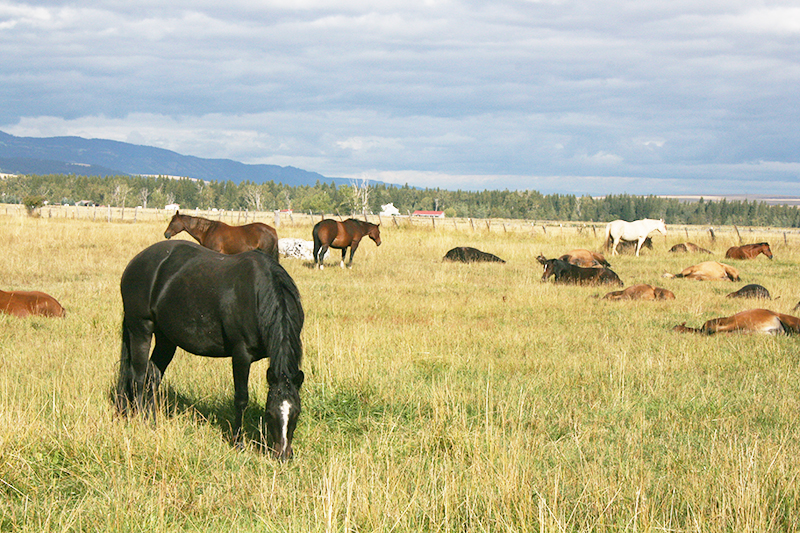Learn and Implement “Protective Feeding Guidelines”
by Dr. Juliet M. Getty, Ph.D.
 I continually urge horse owners to “feed your horse like a horse.” This means, simply, that a horse fed according to his physiology and instincts will be healthier. Free choice forage is the first line of defense against ulcers as a steady, constant supply of hay or pasture grasses keeps your horse’s digestive system healthy. It’s especially important in ulcer prevention. Basic knowledge of horse anatomy reveals why. Unlike a human, the horse’s stomach secretes acid all the time, even when empty. Chewing creates saliva, a natural antacid. If left without food horses will chew on whatever they can, even their own manure, to neutralize the acid that is causing them physical pain and mental discomfort. If left with absolutely nothing to chew on, a horse commonly develops ulcers.
I continually urge horse owners to “feed your horse like a horse.” This means, simply, that a horse fed according to his physiology and instincts will be healthier. Free choice forage is the first line of defense against ulcers as a steady, constant supply of hay or pasture grasses keeps your horse’s digestive system healthy. It’s especially important in ulcer prevention. Basic knowledge of horse anatomy reveals why. Unlike a human, the horse’s stomach secretes acid all the time, even when empty. Chewing creates saliva, a natural antacid. If left without food horses will chew on whatever they can, even their own manure, to neutralize the acid that is causing them physical pain and mental discomfort. If left with absolutely nothing to chew on, a horse commonly develops ulcers.
Horses in the wild do not get ulcers. The diet and lifestyle we impose on domestic horses is to blame for this disabling condition. The good news is we have the ability to prevent ulcers through proper feeding and stress reduction. Besides free choice forage, there is more horse owners can do. I call the following protective feeding guidelines:
- Avoid oats and other cereal grains (corn, barley, wheat, rice, etc.). Starchy feeds can lead to ulcers by stimulating stomach cells to produce more acid and encouraging acid production through bacterial fermentation. In addition, grains move through the stomach quickly, leaving an empty stomach that is vulnerable to acid.
- Feed beet pulp instead of cereal grains. It has as many calories as oats without the propensity for acid production found with starch.
- If you feed extra fat, choose the right type. Vegetable oils, such as soybean and corn oils, are the most popular fat sources but they promote inflammation due to their high omega 6 content. Instead, choose vegetable sources that are high in omega 3s such as flax (meal or oil) or chia seeds, to actually reduce the inflammation experienced with ulcers.
- Provide high-quality protein. Legumes such as alfalfa, soybean meal, and split peas will complement the rest of the diet, offering enough amino acids (building blocks of protein) to allow for proper maintenance and healing. Plus, alfalfa hay should be offered to any horse who is prone toward developing an ulcer (such as during stall confinement) because it is an excellent buffer.
- Feed the hind gut microbial population. Fermentation products and yeast feed the microbes living in the hind gut (cecum and large colon). This makes digestion more efficient and promotes B vitamin synthesis to heal the digestive tract.
- Offer additional B vitamins. Stress (from pain or difficult situation) uses up B vitamins at a rapid rate. Offer a B-complex preparation that includes all 8 B-vitamins, but that does not have added iron (there is plenty of iron in forage and supplementation is rarely needed).
Stress, such as an unfamiliar environment, loss of a buddy, stalling, training, travel and performance can also promote acid production. A horse that is moved into a stall after being used to pasture turnout is likely to develop a gastric ulcer in less than a week. With this in mind, make adjustments to your horse’s lifestyle that reduce stress. Even a horse that appears calm can have an ulcer.
The best way to avoid an ulcer is to allow your horse to be a horse. Give him pasture turnout – the more time the better. I realize that it is not always feasible to give a horse unlimited turnout, but keeping hay in front of him at all times while confined will go a long way toward protecting his digestive system.
Juliet M. Getty, Ph.D. is an internationally respected, independent equine nutritionist who believes that optimizing horse health comes from understanding how the horse’s physiology and instincts determine the correct feeding and nutrition practices. She is available for private consultations and speaking engagements. Contact her through www.gettyequinenutrition.com.

Juliet M. Getty, Ph.D. is an independent equine nutritionist with a wide U.S. and international following. Her research-based approach optimizes equine health by aligning physiology and instincts with correct feeding and nutrition practices. Dr. Getty’s goal is to empower the horseperson with the confidence and knowledge to provide the best nutrition for his or her horse’s needs. Learn more at www.gettyequinenutrition.com.

